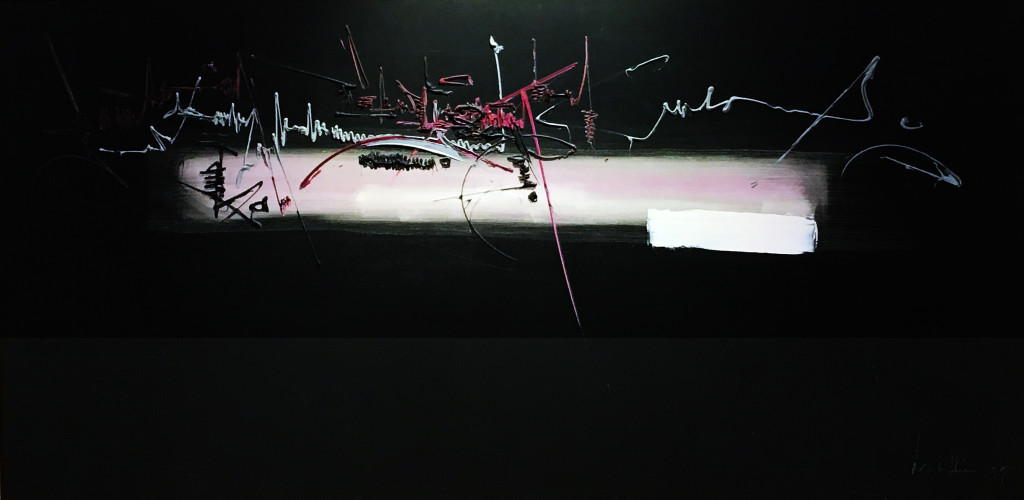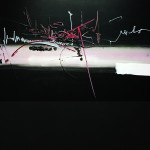Lothaire Sort Secretment De Leon
1959
Oil on canvas
38 1/4 x 76 7/8 inches (97.20cm x 195.40cm)
Signed and dated lower right and titled, signed, and dated on stretcher verso: “Lothaire Sort Secretment de Leon – Mathieu 1959”
Ex-collection
The Artist
Kootz Gallery, New York (Partial label verso)
Private collection , Palm Beach until 2016
Lothaire Sort Secrement de Leon is a prime example of Mathieu’s tightly-wound, energetic style of the late-1950s. An opaque black ground activates the bright white central elements, which seem to glow with a pinkish light as they streak across the center of the large canvas. In contrast to these thick brushstrokes, a tangle of calligraphic lines has been laid over and above the central element. Executed in white, black, and red, these painterly lines exude the vigor with which Mathieu approached his process. Applying paint directly from the tube, the artist worked quickly and with great energy, repeatedly pacing back for a wide view and stepping in close to make his mark. The end result retains a sense of the artist’s intensity, its large surface a testament to his impassioned process.
Largely self-taught, Mathieu moved to Paris in 1947 and quickly became entrenched in the avant-garde artistic circles of Camille Bryen, Wols (Alfred Otto Wolfgang Schulze), and others. That same year Mathieu organized an exhibition entitled Vers l’abstraction lyrique at the Galerie du Luxembourg, coining the term “lyrical abstraction” that would often be used to describe the Parisian counterpart of American abstract expressionism. Mathieu was very much a part of the development of this movement, participating in 1948 with Hans Hartung, Wols, Francis Picabia, François Stahly, Michel Tapié, and Bryen in the self-titled exhibition HWPSMTB at the Collette Allendy Gallery, marking the birth of Art Informel. He would hold his first solo exhibition at Galerie René Drouin two years later. With French critic Tapié, Mathieu set the American and French schools against one another in the exhibition Véhémences confrontées (Opposing Forces) of 1951. This seminal exhibition brought together works by artists working on both sides of the Atlantic, prompting many critics to attempt to define the growing Parisian movement.
Within French lyrical abstraction, or art informel, Mathieu cut unique figure. Self- possessed and confident, the artist reveled in the performative side of action painting and became known for his public spectacles and dramatic staged events. One such performance, the creation of the monumental canvas La Bataille de Bouvines in 1954, was documented by Life magazine on the occasion of the 10th Salon de Mai. This, along with many other photographic and televisual appearances, captures Mathieu approaching his large canvases with carnivorous glee – he seems to stalk the surface, approaching and retreating many times before finally attacking with tube or brush, applying his pigments with a vigorous energy. These performances fuse the gestural style of midcentury informel with the dramatic impulse of more conceptual French artists such as Yves Klein.
Mathieu saw his oeuvre as a modern iteration of monumental history painting in the French tradition, with himself playing the part of a latter-day Jacques-Louis David or Eugène Delacroix. Accordingly, his works are often titled after grand battles, such as La Bataille de Bouvines, or other historical events of import, such as Couronnement de Charlemagne (1956). This historical alignment carried into the physical presence of Mathieu’s canvases, which often approach the monumental.
In addition to his interest in American abstract expressionism, Mathieu also fostered a connection to the Japanese Gutai movement. In their 1956 manifesto, the Gutai group stated: “Concerning contemporary art, we respect Pollock and Mathieu because their
work seems to embody cried uttered out of matter, pigment and enamel. Their work is about merging with matter using techniques that are particularly reflective of their own individual personalities. More precisely, they put themselves at the service of matter in a powerfully symbolic way.” (1)
Georges Mathieu enjoyed enormous success in the 1960s and 1970s, and in addition to his fine art output he designed several posters for Air France in 1967, the ten franc coin in 1974, and several commemorative stamps for the French government. The artist settled in the suburbs of Paris in his later career, where he continued to paint until his death in 2012. His work can now be found in important collections around the world, including the Museum of Modern Art, New York; the Centre Pompidou, Paris; the Art Institute of Chicago; and the National Museum of Art, Osaka, Japan, among many others.
1. Quoted in Bernard Marcadé, “Pretentious? Moi?” Tate Etc. Issue 19: Spring 2010.


 Lothaire Sort Secretment De Leon
Lothaire Sort Secretment De Leon